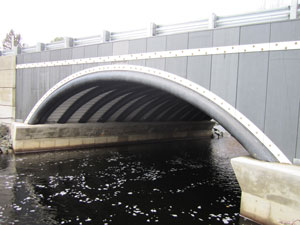FRP Ushers in Bridge in a Backpack System
 According to the Federal Highway Administration (FHWA), as of December 2013, there are over 29,000 structurally deficient and functionally obsolete bridges within the National Highway System and over 140,000 outside of the system. http://www.fhwa.dot.gov/bridge/nbi/no10/defbr13.cfm
According to the Federal Highway Administration (FHWA), as of December 2013, there are over 29,000 structurally deficient and functionally obsolete bridges within the National Highway System and over 140,000 outside of the system. http://www.fhwa.dot.gov/bridge/nbi/no10/defbr13.cfm
Factors leading to a bridge’s deficiency are usually directly attributed to corrosion. Hybrid composite concrete bridge technology has offered a step-in solution to reduce upfront costs in material, fabrication time, transportation, construction time and maintenance issues from traditional bridges. Advanced Infrastructure Technologies (AIT) offers a 100 – year lifespan system which utilizes FRP composite tubes to act as external reinforcements and a permanent formwork for cast-in-place structures to replace steel rebar, virtually eliminating all exposure to rust and corrosion – an $8.3 billion direct cost problem for our nation’s infrastructure, according to a 2002 FHWA study. http://www.nace.org/uploadedFiles/Publications/ccsupp.pdf
In 2013, AIT’s Bridge-in-a-Backpack System incorporated Strongwell’s COMPOSOLITE® building panels within their design. AIT’s system can be designed for bridges which are of single or multiple spans.
The Jenkins Bridge located in Maine was designed by Kleinfleder Sea Augusta and installed by Wyman and Simpson, Inc. This bridge spans over 28’, has a width of 34’ and a 6’ rise. This bridge was rapidly installed with the COMPOSOLITE® Building System to create a corrosion resistant soil retention headwall system. Within its first year the product encountered an ice floe which dammed up the bridge opening, leading to extreme hydraulic forces, with no effect on the bridge.
Utilizing this quick-install system with materials which provide excellent high strength to low weight ratios translated into lower installed costs through the reduction of personnel, equipment, traffic congestion, and construction schedules.
The AIT Composite Arch Bridge system is an excellent example of how composites can be used to replace steel in vehicular superstructures in corrosive fresh and saltwater environments without compromising aesthetic appeal or increasing maintenance requirements.